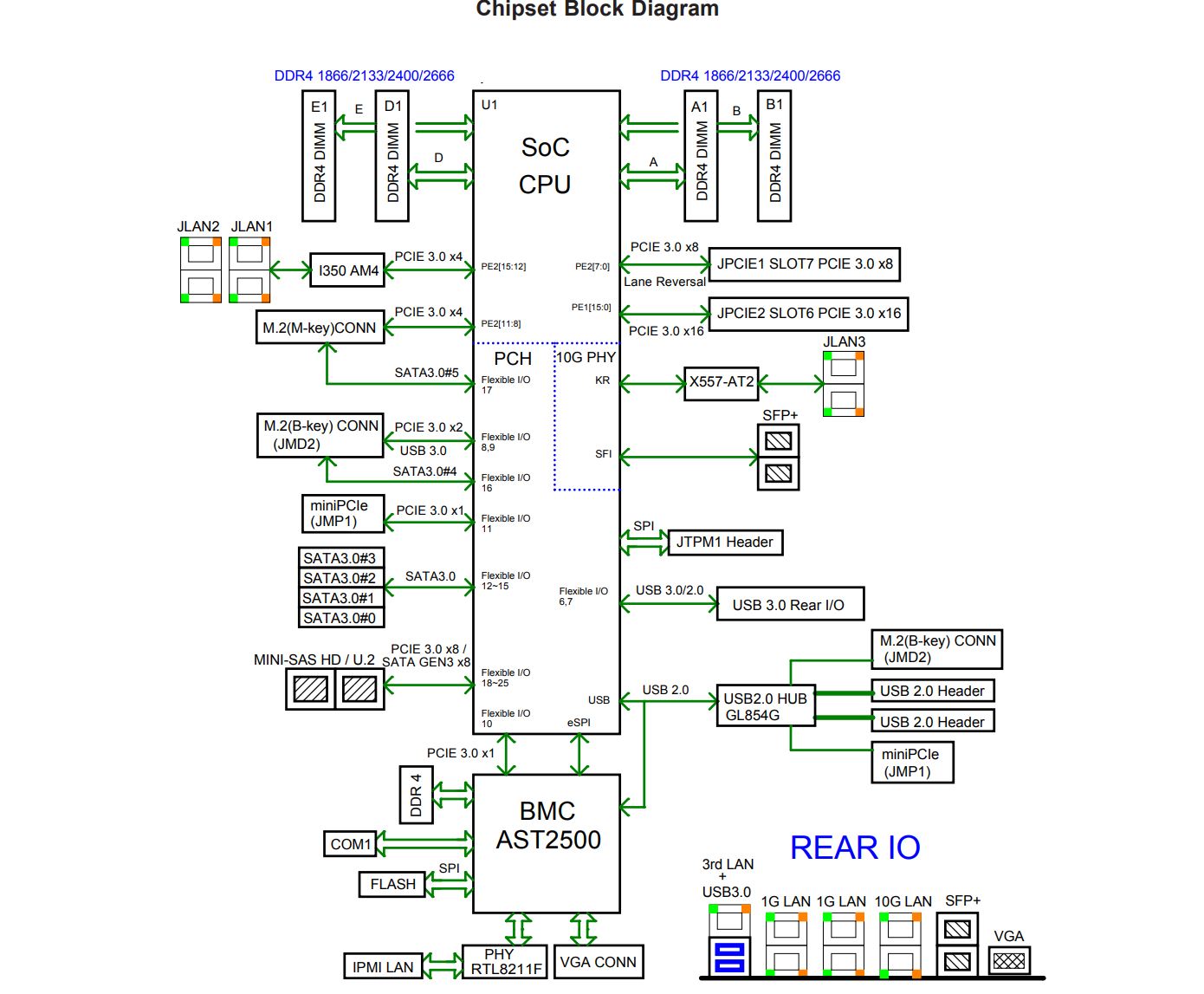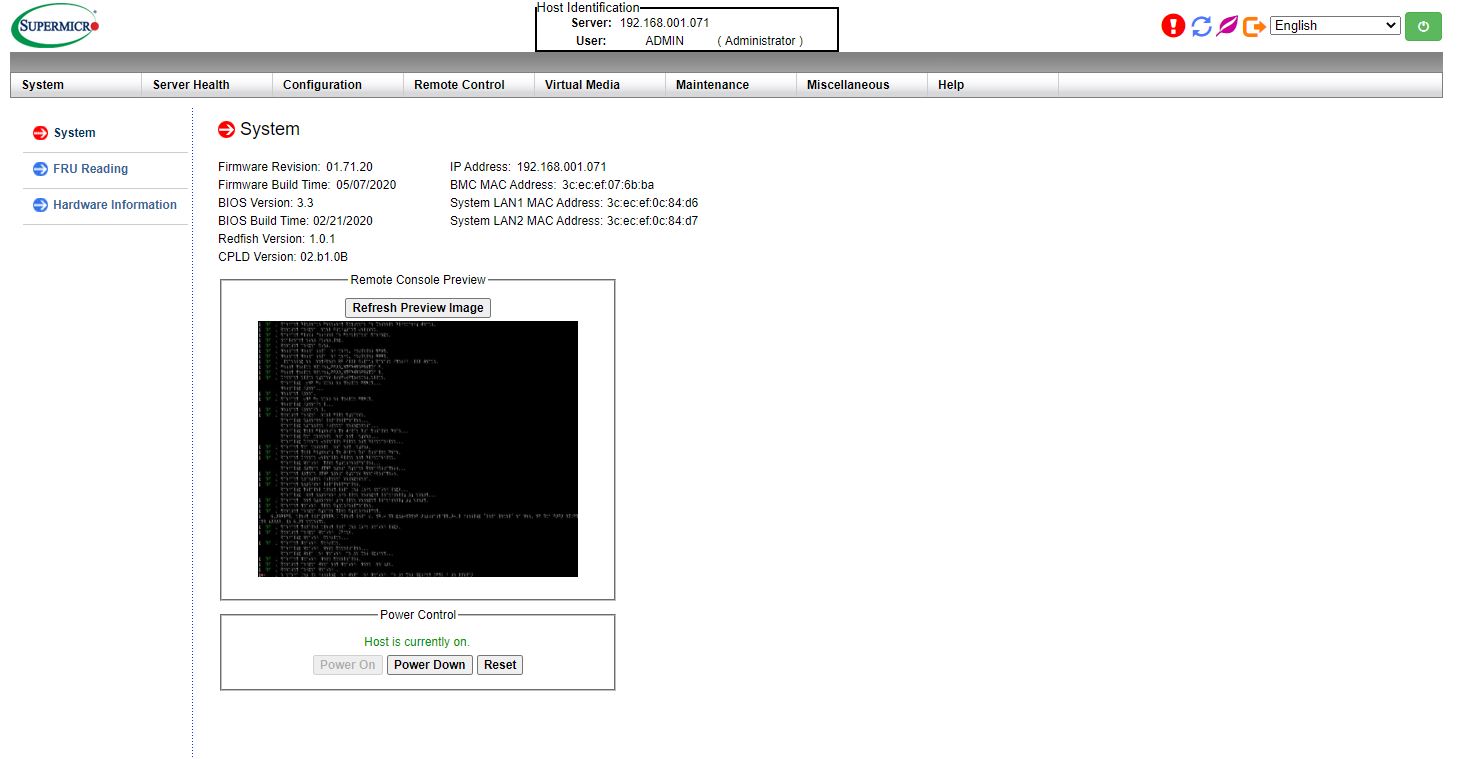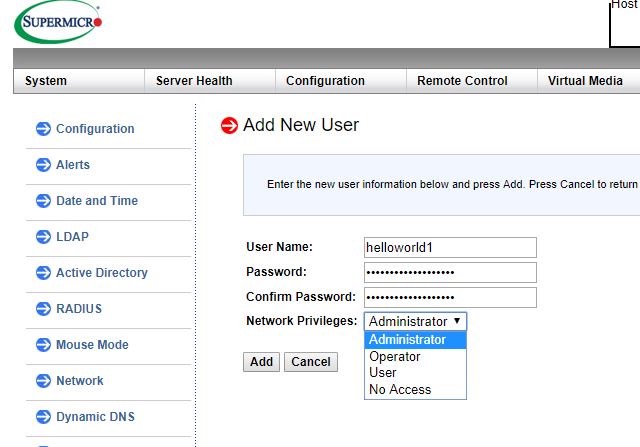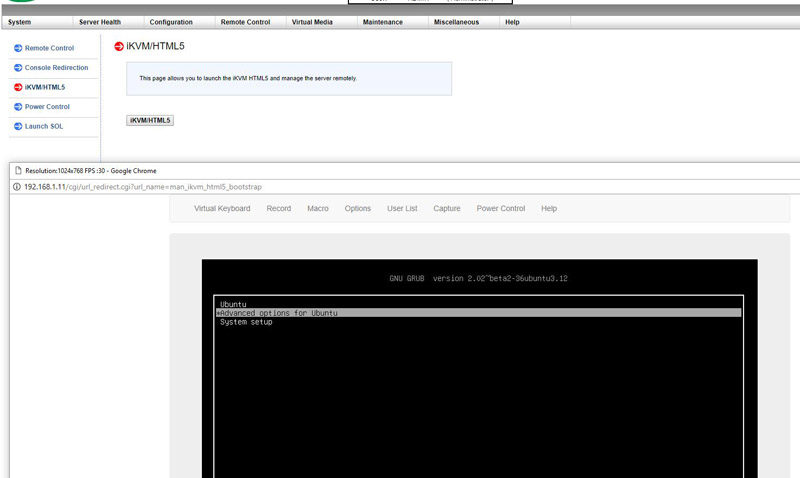Supermicro E300-9D-4CN8TP Block Diagram
The block diagram of this system is very interesting to look at for a number of reasons:

First, we can see the SoC and PCH sides split here, which is how we have discussed the Xeon D-2100 series since it launched. Skylake-SP cores plus a Lewisburg PCH. One can see the 32 lanes of PCIe connectivity directly from the SoC plus the flexible I/O lanes being broken out on the platform. One can also see the quad 10Gbps networking ports split to the SFP+ and the Intel X557-AT2 which is being used for the 10Gbase-T PHY. This looks remarkably similar to how one would construct the PCH infrastructure on a mainstream motherboard using an Intel C624 PCH. Hopefully, this diagram helps our readers understand how this system is constructed.
Supermicro E300-9D-4CN8TP Management
These days, out of band management is a standard feature on servers. Supermicro offers an industry-standard solution for traditional management, including a WebGUI. This is based on the ASPEED AST2500 solution, a leader in the BMC field. The company is also supporting the Redfish management standard. Something that we wanted to highlight is that the password has changed.

Our system did not use the unique password due to when it was purchased, however if you were to purchase one today, it would likely have a unique password. For a quick overview of why Supermicro and the rest of the industry are moving to unique BMC passwords, you can see Why Your Favorite Default Passwords Are Changing and the accompanying video:
On this server, we see similar features as we would across the Supermicro A2/X11/H12 ranges. That means whether you are using an embedded Intel motherboard or a 4U Intel Xeon or AMD EPYC storage server, you will have a similar look and feel to the management experience.

In the latest generation of Supermicro IPMI is an HTML5 iKVM. One no longer needs to use a Java console to get remote KVM access to their server.

Currently, Supermicro allows users to utilize Serial-over-LAN, Java or HTML5 consoles from before a system is turned on, all the way into the OS. Other vendors such as HPE, Dell EMC, and Lenovo charge an additional license upgrade for this capability (among others with their higher license levels.) That is an extremely popular feature. One can also perform BIOS updates using the Web GUI but that feature does require a relatively low-cost license (around $20 street price.) That is a feature we wish Supermicro would include with their systems across product lines.
This pricing differential for a serviceable iKVM functionality is a big deal in this segment. Adding a $200 license to a server can add 10% or more in the embedded platform costs. Supermicro’s iKVM feature is extremely popular due to its inclusion with the server.
Next, we are going to discuss performance. If you read our recent Intel Xeon D-2123IT benchmarks and review piece, you can skip this section as it is effectively the same as the Supermicro platform we used for that review from a performance perspective.




Thank You for your solid review of my dream motherboard! Yes, I am one of those Supermicro X11SDV-4C-TP8F fanboys;). Best Regards, ABQ :)
I know as the readers of STH we do not like that STH is now doing video, but the video for this one is like a doctoral dissertation on this system and the current state of the Xeon D-2100 series.
I’d say you should make the Xeon D insight around pricing from the video its own article. That’s a stinger in the video.
Anyone that has one and can comment on how picky this system is regarding SFP+ optics/DAC? I have the previous generation and with most Intel drivers these started requiring Intel coded DACs halfway through their lifecycle, causing major issues when this happened after scheduled updates on devices in the field.
Intel forgot to put a QAT in this processor :)
Not great for IPSEC, openssl and crypto workloads.
VPNs are quite popular in 2021.
But they offer nice xeon-d models with hardware crypto acceleration.
The Supermicro SuperServer E300-9D-8CN8TP has some distinct advantages. The E300-9D-8CN8TP sports an Intel® Xeon® D-2146NT, which has Intel Quick Assist Technology. The reviewed Supermicro SuperServer E300-9D-4CN8TP sports the more limited Intel® Xeon® D-2123IT, which lacks Intel QAT. The E300-9D-8CN8TP adds 4C and a sizeable $500 on Amazon. An alternative might be to add an Intel QAT accelerator, but there would need to be available power and you’d lose the PCIe slot. Used Intel QAT accelerators are available on eBay for cheap.
it’s seems a great option for home server but for 8-900 $ it’s to high
The Supermicro X11SDV-4C-TP8F motherboards are $449 NIB & free shipping, if you already have a case.
@Fred Tang: I am a long-time reader too and enjoy the videos.. So it is not all of us.
I was sceptic at first, but it provides additional value and is not just the article script in video form.
I urge other video sceptics to give it a try!
And to the die-hard anti-video crowd: Any tech journalist knows, that without YouTube, traditional online journalism is dead as disco. It is a matter of survival, plain and simple.
@ABQ Supermicro X11SDV-4C-TP8F in italy is over 700€ on ebay 500$ plus 2-300$ of duties
usa’s price is very differente for europeans people for costums duties and VAT (in italy is 22%)
BMC/IPMI licenses are BS, which is why I’m happy purchasing Gigabyte/ASrock Rack.
I’m running 2 of these for 2 Years 7/24 now without any Problems. Perfect for a VMWARE Home-Lab, but not only. I’ve replaced the (loud) Stock Fan’s with Noctua Fan’s – they are not so loud and cools good (Noctua NF-A4x20 PWM). Also added the RSC-RR1U-E8 expansion for the low Profile Riser Card (AOC-SLG3-2M2-O), so you can run 2 additional M.2 NVMe SSDs. Perfect for running/testing VSAN (Robo). As i was so satisfied with this Supermicro-Solution i run now 2 additional 8-Core Versions of this Barebones (E300-9D-8CN8TP) for running/testing “remote-site replication” scenarios. I can only recommend this Barebones.
Hi Giuse! Did you replace the fans of the E300 chassis with Noctua fans? Are you happy with them? Did it get silent?
Hi Giuse! greeting,
do you run E300-9D-4CN8TP or E300-9D-8CN8TP,
I’m looking for my expansion of 2x for workload home lab (VMware SDDC Stack) on E300-9D-8CN8TP?
do you advice for the same.
SYS-E300-9D-8CN8TP
Release Date: Nov 2018 (EOL: Q1 2025)
CPU: Intel Xeon D-2146NT (8c/16t)
Memory: 512GB
Storage: 1 x M.2 (Additional 1 x M.2 possible with PCIe Add-in-Card or 2 x M.2 possible with AOC-SLG3-2M2)
Max Devices: 3
Network: 2 x 10GbE, 2 x 10GbE (SFP+), 4 x 1GbE, 1 x 1GbE (IPMI)
VMware HCL: Yes (supports up to vSphere 7.0 Update 1)
which one you recommend:
1-https://www.amazon.com/gp/product/B07JN5T2RT/ref=ox_sc_saved_title_6?smid=AEELF2HAVZFED&psc=1
2-https://www.amazon.com/gp/product/B07RCN114X/ref=ox_sc_saved_title_5?smid=ATVPDKIKX0DER&psc=1